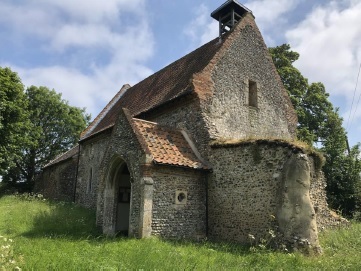The Vanished Village
All Saints’ was an essential part of the medieval village. The centre of the village was to the north-east of the church, approximately where the farm is today.
A track, part of which is still a public footpath, linked the church and the village, running along the far side of the small stream which is the western boundary of the churchyard. There is a footbridge across the stream, accessible in the north-west corner of the churchyard. This was probably where villagers entered the church.
Archaeological research has revealed the outlines of houses, fields, a village green and a manor house. The surviving ponds were probably fishponds to help feed the village. Domesday indicates a small settlement and it seems Waterden remained that way. By the 16th century it was no longer ranked as a separate village for taxation. Successive prominent local families owned the land until Sir Edward Coke bought it in 1604, by which time enclosure of the land had probably begun.
Sir Edward was an ancestor of the Earls of Leicester, whose seat is at nearby Holkham Hall. The land remains part of the estate of the Earls of Leicester and today broadly corresponds to what is known as Waterden Farm.
Land continued to be enclosed into the 18th century. The village vanished and evolved into a manor house and farm buildings but Waterden was never depopulated entirely. In 1861 the census recorded a population of 44, conceivably the highest ever. Most, however, lived in only the farmhouse and the rectory and some were workers on the farm who came from neighbouring villages.
The 16th century manor house was demolished and replaced by the existing farmhouse in 1781. The barn, which can be seen from the church, is very old in origin and contains some masonry, including carved beasts and gargoyles, which may have come from the church. In the early 19th century the farm buildings were described as ‘perhaps the finest set of farm premises in Great Britain’.


